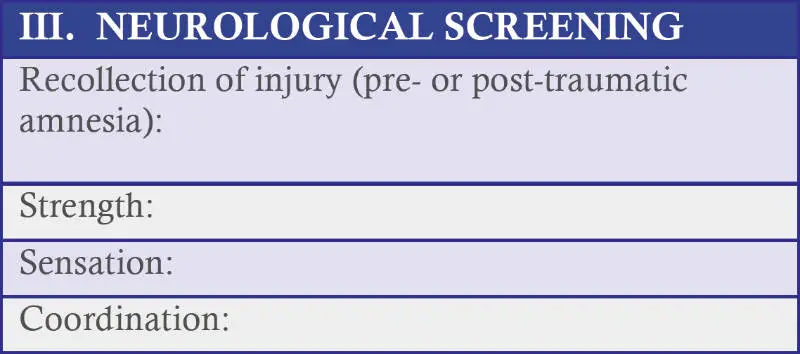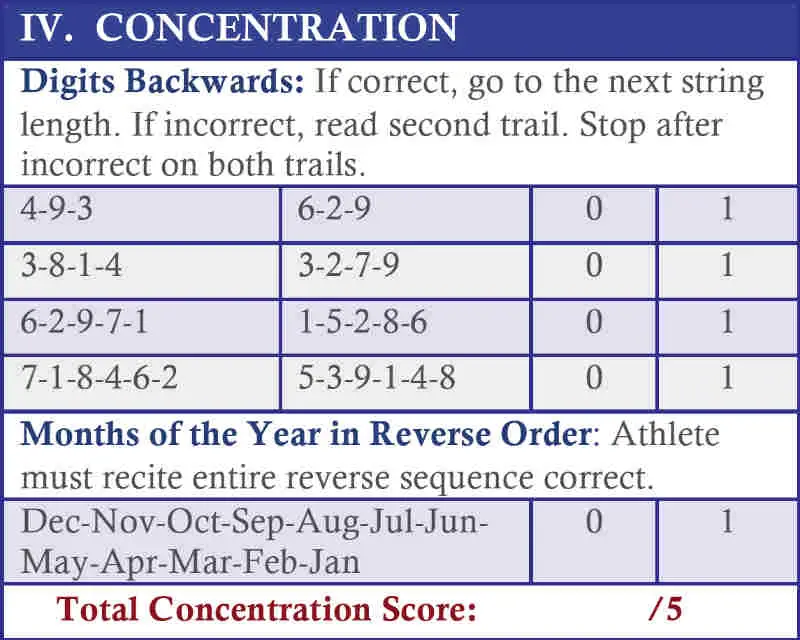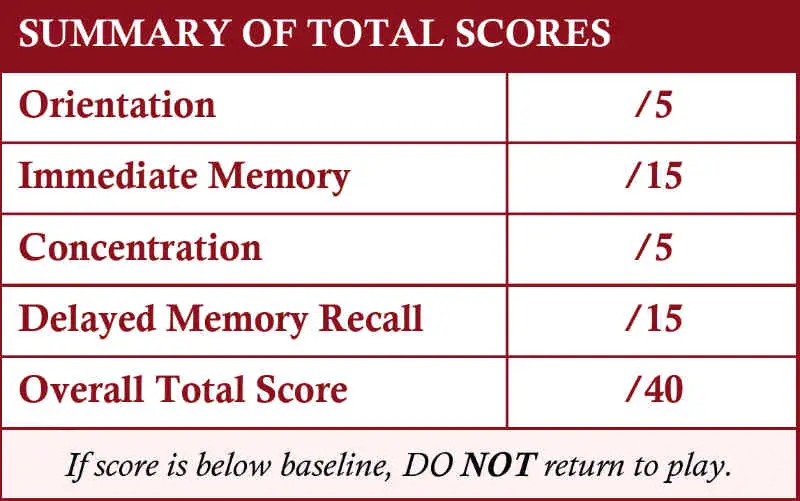During last year’s Arizona game, Dillon Mitchell touched the ball on a crossing route, then got hit by Arizona’s Tristan Cooper and the ball went flying away. Mitchell fell to the turf and stayed there. Then what?
This article is going to cover the Standard Assessment of Concussion (SAC) test. It’s a one-page test that will give us an idea as to what happens on the sidelines when medical personnel assist a player suspected of having a concussion.
Baseline Testing
The first thing to know about the SAC concussion test is that players have taken it before. Before even practicing for the University of Oregon Ducks football team, medical personnel will give the SAC test in order to see what a player’s score is when healthy.
So, once a player feels a bit woozy, they are taken to the locker room as someone pulls out the first test, checking the baseline score. He takes the test again and the medical personnel compare the two scores. Let’s take a look at the test to give you an idea of what the athletes go through.
DISCLOSURE: This test should only be administered by medical personnel trained in concussion diagnosis and management.
PART I: Orientation
To start, the trainer will say, “I’m going to ask you some questions. Please listen carefully and give your best effort.”
When you’re ready, they will ask, “What month is it?”

Then, circle “1” if you answer correctly or “0” if you cannot.
“What is today’s date?” and so forth… Each correct answer gets 1 point and is totaled at the bottom.
The goal of the SAC test is to evaluate your mental capacity. To do that, the questions are administered while healthy, and test your ability to orient yourself to the surroundings, date and time. That way, there is something to compare with your concussed answers.
Recently, I went through the PAC-12 concussion protocols, and I chuckled out loud when I saw this question on the Arizona State concussion list: “Did your team win its last game?”
Let’s go to the next part of the test.
Part II: Immediate Memory
“I’m going to test your memory. I will read you a list of words and when I am done; repeat back as many words as you can remember. Ready? Elbow, Apple, Carpet, Saddle, Bubble.”

“So, you read these five words, and I go down the Trial 1 column and circle a ‘1’ for any that you repeat back to me. Then the process is repeated twice more. I add up your score, and we move right along.
Do you see that note on the bottom? There’s going to be a pop-quiz in the last part of this test where you’re going to have to remember these words and repeat them again. Remember, we’re testing the brain’s capacity to remember and recall.”
Part III: Neurological Screening
Trained medical personnel will examine you in this section. Clearly, I am not trained in concussion diagnosis or management, so I’ll simply say this is where medical personnel would follow their procedures.

Part IV: Concentration
“These questions that I’m asking are standard across other concussion tests as well. There is a SCAT3 or SCAT5 test used by other universities in the NCAA, and those two tests are recognized by international sports bodies (e.g. FIFA and the Olympics). These questions are designed to access different aspects of your brain, so now we are going to test your ability to concentrate.
I am going to read you a string of numbers and when I am done, you repeat them back to me backwards, in reverse order of how I read them to you.”
For example, if I say, ‘four, seven, one,’ you would say, ‘one, seven, four.'”

Part V: Exertional Maneuvers
We’re almost done. “What we’re going to do next is test your balance and ability to move. I’m going to request that you do the following for me: five jumping jacks…”

If it is clear that you cannot complete these, you will not be able to return to the field.
Part VI: Delayed Memory Recall
“Okay, do you remember the list of words I read a few times earlier? Yes, those words that I read three times. Tell me as many words from the list as you can remember, in any order. I can’t read them to you again.”

“Thank you for that first effort. I’m going to ask you to take a moment and repeat them back to me again. I won’t be able to read them back to you, but think back to when I first said them.” Repeat. Score.
Conclusion: Final Scores
I noted earlier the SCAT3 and SCAT5 tests. There are also different versions of the SAC test and scoring. The one we’ve gone through is from the Brain Injury Association of America, but there are different ones and different scoring (some with 30 points). Here is how this SAC is scored:

By now, someone has looked at that previous SAC test that you took before the season started, to see what your previous Overall Total Score was. You see the guideline at the bottom of the red box above: “If score is below baseline, DO NOT return to play.”
Other Potential Tests
There are other tests employed by trained medical personnel in diagnosing a concussion such as the King-Devick eye movement test, which is given to all Oregon athletes. In the end, someone with expertise in diagnosing concussions is going to make a determination on whether you can return to play or not.
The exciting thing about the ever-reforming concussion guidelines is that the first rule is to remove the athlete from practice or competition: protect the student-athlete. In some sense, understanding this process now helps me understand why an athlete would need to go to a locker-room or quieter place in order to go through these questions and tests.
Ever Had a Concussion?
Some of us played sports before concussion protocols were introduced. Some have had the benefit of concussion protocols. Feel free to share an experience you’ve gone through before and share your insights about concussions and the attention that is given to them today.
If you have a reaction to the SAC test, share that. As you went through this test, were there any sections that you thought you might struggle with even without a concussion?
If you have had a concussion, what happened to you? Did you see stars? How did you know you were injured or hurt? How did others around you react? Please, share your story. If you have had a non-sports concussion, share that as well.
Source: the phrasing of the questions used for this SAC test were taken from the SAC test used by the Warren Township Schools (New Jersey).
Ugly Duckling
Covington, Kentucky Top Photo by Kevin Cline

Chris Brouilette, the FishDuck.com Volunteer editor for this article, is a current student at the University of Oregon from Sterling, Illinois.
Ugly Duckling was part of a flock that migrated from east of the Cascades many seasons ago, was raised in Willamette Valley Ponds, and is proud to be part of the green and yellow.


